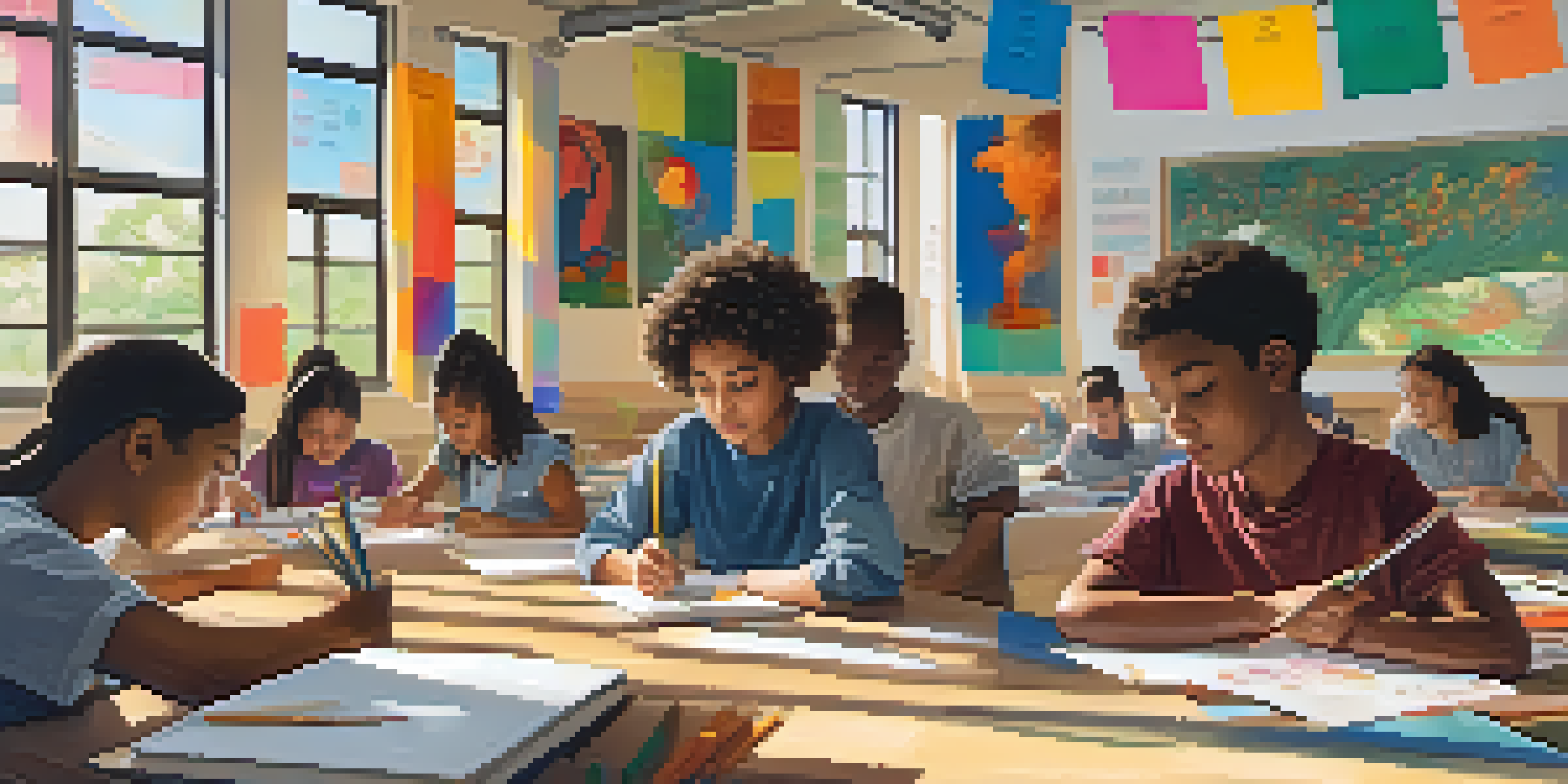The Challenges of Standardized Testing in NYC Public Education

Understanding Standardized Testing in NYC Public Schools
Standardized testing in NYC public schools is designed to measure student performance across consistent metrics. These assessments, such as the New York State Exams, are intended to gauge academic achievement and hold schools accountable. However, the uniformity of these tests often raises questions about their effectiveness in truly reflecting a student's understanding and capabilities.
Standardized tests may measure performance, but they often fail to capture the full spectrum of a student's abilities.
For many students, these tests are a high-stakes endeavor that can determine their educational trajectory. The pressure to perform well can create anxiety and stress, impacting their overall learning experience. This brings us to the heart of the debate: are these tests a fair measure of a student's abilities?
Moreover, the reliance on standardized tests for evaluating schools can lead to a narrow focus on test preparation rather than holistic education. Schools may prioritize teaching to the test, leaving little room for creativity, critical thinking, and practical skills. This situation can create an educational environment that feels more like a factory than a nurturing space for learning.
Equity Concerns in Standardized Testing
One of the most pressing issues surrounding standardized testing is equity. Students from diverse backgrounds often face different challenges that can affect their performance. For example, children from low-income families may not have access to the same resources, such as tutoring or a quiet place to study, as their more affluent peers.

This disparity can skew test results and misrepresent a school's effectiveness. When test scores are used to allocate funding or resources, it can perpetuate cycles of disadvantage. Hence, the question arises: how can we ensure that all students have an equitable chance to succeed?
Equity Issues in Standardized Testing
Standardized testing often disadvantages students from low-income backgrounds, affecting their performance and perpetuating inequalities.
Efforts to address these disparities are underway, with initiatives aimed at providing additional support to underprivileged schools. However, systemic change is slow, and many argue that standardized testing itself needs a comprehensive overhaul to be truly equitable. A more inclusive approach could lead to more accurate assessments of student learning and potential.
The Impact of Test Anxiety on Students
Test anxiety is a significant concern in the context of standardized testing, affecting many students in NYC. The pressure to perform can lead to heightened stress levels, which may detract from their ability to showcase their true skills. For some students, this anxiety can be debilitating, resulting in lower scores that do not reflect their actual abilities.
Education is not preparation for life; education is life itself.
Schools and educators are increasingly recognizing the importance of mental health and are seeking ways to alleviate this pressure. Techniques such as mindfulness practices and alternative assessment methods are being explored to create a more supportive testing environment. However, the challenge remains in balancing the need for accountability with the well-being of students.
Moreover, the narrative around test scores can contribute to a negative self-image for students who struggle with test-taking. It's essential to foster an educational atmosphere that values learning and growth over mere numerical results. By addressing test anxiety, we can help students build confidence and resilience in their academic journeys.
Parental Perspectives on Standardized Testing
Parents play a crucial role in the conversation around standardized testing in NYC. Many express concerns about the pressures their children face and the implications of test scores on future opportunities. For some families, opting out of standardized testing has become an appealing choice, as they seek alternatives that prioritize their child's unique learning style.
However, this decision can be fraught with complications as it may affect a child's school enrollment or funding for their school. Parents often find themselves navigating a complex landscape of regulations and policies, which can be overwhelming. So, how can parents advocate effectively for their children while engaging with the educational system?
Test Anxiety Affects Student Performance
The pressure surrounding standardized tests can lead to significant anxiety, hindering students from showcasing their true abilities.
Engaging in school meetings, forming parent-teacher associations, and collaborating with other parents can amplify their voices. By fostering open communication with educators, parents can help shape a more balanced approach to assessment that considers both academic performance and individual student needs. This collective effort is vital for driving change.
The Role of Teachers in Standardized Testing
Teachers are at the forefront of the standardized testing debate, often feeling the weight of the system on their shoulders. They are responsible for preparing students for these assessments, which can sometimes overshadow their primary role of fostering a love for learning. The pressure to achieve high test scores can influence teaching methods, often leaning towards rote memorization rather than critical thinking.
Many educators advocate for a more balanced approach, emphasizing the importance of formative assessments that provide ongoing feedback rather than relying solely on high-stakes tests. These alternative methods can offer a fuller picture of student progress and needs, allowing for more personalized instruction. But how can teachers effectively implement these strategies within the constraints of standardized testing?
Professional development and collaboration among teachers can lead to innovative practices that prioritize student learning. By sharing resources and strategies, educators can create a supportive network that enhances teaching effectiveness. Ultimately, empowering teachers can lead to a more enriching educational experience for students.
Alternative Assessment Methods in Education
As the conversation around standardized testing evolves, alternative assessment methods are gaining traction in NYC public schools. These approaches can include project-based assessments, portfolios, and performance tasks that allow students to demonstrate their understanding in diverse ways. Such methods can provide a more comprehensive view of a student's abilities beyond a single test score.
Implementing alternative assessments, however, is not without its challenges. Teachers need adequate training and resources to develop and evaluate these methods effectively. Moreover, there is often resistance from stakeholders who are accustomed to traditional testing practices, raising questions about accountability and comparability.
Need for Alternative Assessment Methods
Alternative assessment approaches, like project-based tasks, can provide a more comprehensive understanding of student learning beyond traditional tests.
Despite these hurdles, many educators and administrators are optimistic about the future of assessments in education. By prioritizing creativity and critical thinking, alternative methods can foster a more well-rounded educational experience. As schools continue to explore these options, the hope is to cultivate a system that truly reflects student learning and potential.
The Future of Standardized Testing in NYC Education
Looking ahead, the future of standardized testing in NYC public education remains uncertain. Increasing awareness of its limitations has sparked a broader dialogue about educational reform. Many stakeholders are advocating for a reimagined approach to assessment that prioritizes holistic student development over mere test scores.
As educational policies continue to evolve, it’s crucial to consider the voices of students, parents, and educators in shaping these changes. Collaborative efforts can lead to a more equitable and effective system that meets the diverse needs of all learners. The key lies in striking a balance between accountability and fostering a nurturing learning environment.

Ultimately, the goal is to create an educational landscape that values growth, creativity, and individual potential. By embracing innovation and inclusivity, NYC can pave the way for a future where standardized testing is just one of many tools used to assess student achievement. This vision promises to enhance the learning experience for generations to come.